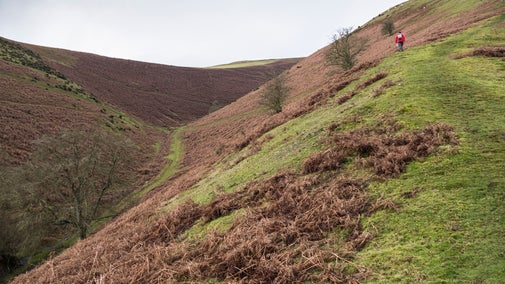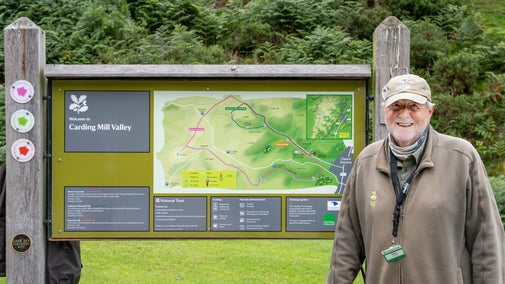Our work at Carding Mill Valley on the Long Mynd

To look after places like Carding Mill Valley and the Long Mynd, important conservation work takes place every day to ensure it is protected for everyone, for ever. Discover some of the important work we do, including heather management, bracken control and footpath maintenance.
Heather management on the Long Mynd
Heather management makes up a huge part of the conservation work we carry out on the Long Mynd. There are a number of reasons why the heather has to be managed by grazing, cutting and burning. It maintains or improves the condition of the heather as well as preventing woodland development, and it improves the habitat for ground nesting birds, in particular the red grouse. It is also good for species of insects, beetle and moth.
Managing the heather
It is important that we encourage the re-growth of young heather so that special wildlife that depend on the heather can thrive. The commoners who own the rights to graze their sheep on the hill benefit from an increase in young heather as it is more digestible, it is more resilient to stock and to trampling than the old heather.
The team manage the heather by cutting and burning patches each year. By burning the heather, these areas form breaks and gaps in the heather which help to provide fire breaks in case of a summer fire which could be devastating, and the breaks also help the grouse by providing feeding and nesting sites.
Burning is the most traditional and effective way to manage the heather. Underneath the older heather a moss layer starts to develop that limits the re-generation of the heather seed. Burning gets rid of the moss very effectively.
In some areas of the Long Mynd burning isn't appropriate, for example we don't burn in highly sensitive areas and around the pools.
When we do it
The team have a small window of opportunity to manage the heather and they try and burn around 10 hectares a year. It has to be done between mid-October and mid-April, although we stop burning by mid-March so that we don't encroach on the nesting season for the grouse.
The burning requires some specific weather conditions as well, we need a few dry days before burning so that the heather isn't damp, and on the day of burning we need ideally a north-easterly wind, no more than 4 miles per hour.
A new purpose
In some cases, we have chosen to cut the heather. This is because the old heather can go on to have other uses. In the past we have sold bailed heather to a filtration company in Holland, it has also been used to thatch a house in Clun and a summer house at Biddulph Grange Garden.
We also use cut heather on our footpaths, in more sensitive areas where we don't want to put down stone, the heather absorbs the moisture stopping the paths from becoming muddy.
Monitoring re-growth
Each year the areas burnt are recorded on a map by our ecologist. Over the years we monitor and assess the condition of the heather. We also carry out wildlife surveys and bird counts with volunteers to see if the number and quantity of species living in and around the heather is increasing.
Pests and disease
The changing climate has an impact on plants across the country. Up to 75 per cent of heather has been lost on the hills at Long Mynd due to a combination of summer drought and damage from the heather beetle, which is able to thrive due to warmer winters.

Bracken control on the Long Mynd
We go to great lengths to try and get the bracken under control on Long Mynd. It is a hugely invasive species, and if left to its own devices it will shade out plants like the heather. We also control it to provide more good grazing areas for the sheep on the hill.
Controlling the bracken
We don't want to get rid of the bracken altogether, as it is an important habitat in its own right, for example where the bracken grows on steep slopes the whinchats choose this as their breeding ground. A thin covering of bracken is also good as it shades the grass, providing food for the sheep, particularly during hot weather.
The team use a couple of methods to control the bracken. The first is to simply cut it - the team aim to cut 60 hectares a year. We use this method as much as we can, but due to the slopes we're confined to the flat areas, although we can reach some steeper slopes with a radio-controlled cutter called Robocutter.
The other option is then to spray the bracken with a herbicide called Azulox, this chemical only kills ferns and it is 95 per cent to 100 per cent effective in controlling the bracken.
The decision to use chemicals isn't taken lightly, permission needs to be given from the Environment Agency in the first instance - you can't re-spray an area for three years, no matter how much the bracken might have grown back, and the team prioritise areas where the bracken is encroaching on the heather. The team aim to spray 20 hectares a year.
A new purpose
In previous years the cut bracken has been collected and sold to visitors as compost for their gardens. Due to how successful the cutting is, we can't do this every year because the bracken has declined so much in these cuts.
How it's monitored
The rangers record what areas they are spraying or cutting each time they do it. These areas are recorded by our ecologist. In the following spring we carry out an assessment of these areas and make a decision on how effective the spraying or cutting has been.
A successful project
Where the team have cut and sprayed, the bracken has been greatly reduced, but it is still providing the much needed cover over the grasses, and the heather is continuing to recover and spread as we would like.
Managing the paths
Carding Mill Valley receives approximately 250,000 visitors a year and perhaps a further 100,000 visit the hill plateau. Inevitably there is wear and tear along with potential damage to sensitive vegetation. The ranger team work with volunteers to repair erosion, clear drains, lay down stone surfaces and build boardwalks as well as bridges.
Thank you
With your ongoing support, we're able to continue our vital conservation work. Thank you for helping to protect these special places.
You might also be interested in
The Stepping Stones Project in the Shropshire Hills
Discover more about the Stepping Stones project, working with partner organisations to create, manage and connect habitats to support nature in the Shropshire Hills.

The Ashbrooke river: past and present
The Ashbrooke river lies at the heart of Carding Mill Valley. It shaped it, it powered its industry, and it is home to a wide variety of wildlife. But how much do you know about the river?

Things to do at Carding Mill Valley on the Long Mynd
Explore the great outdoors at Carding Mill Valley and the Long Mynd. Enjoy a bracing walk, a challenging bike ride, a wild swim, have fun with the family or just take in the views.

Volunteering at Carding Mill Valley on the Long Mynd
Discover what volunteering at Carding Mill Valley and the Long Mynd involves, and the current opportunities available.

People and nature thriving: Our strategy to 2035
Read about our strategy, which focuses on restoring nature, ending unequal access and inspiring more people.

Our cause
We believe that nature, beauty and history are for everyone. That’s why we’re supporting wildlife, protecting historic sites and more. Find out about our work.